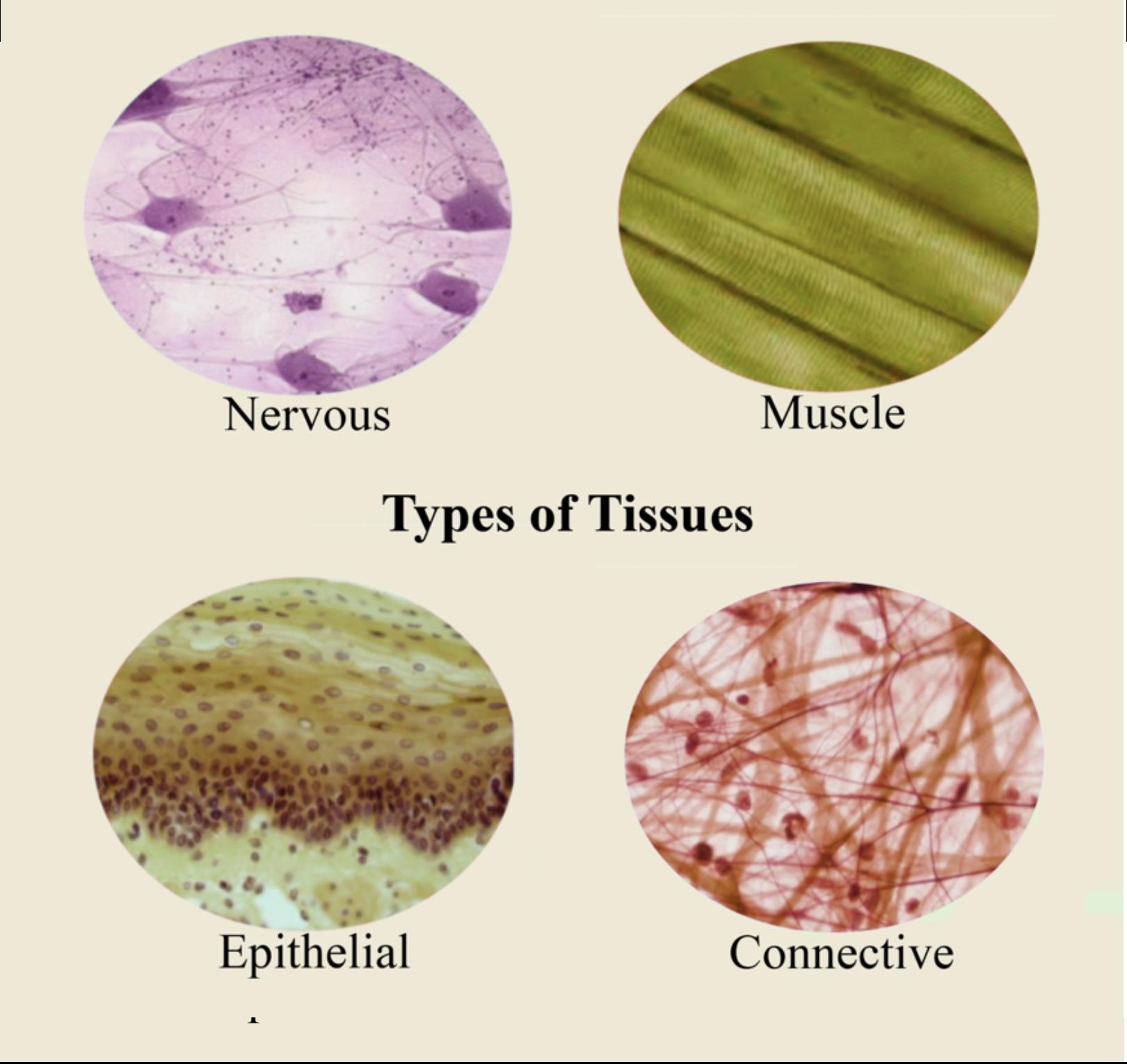
How many different types of tissues are found in the human body?
(a) 4
(b)14
(c)12
(d)40
Answer
558.6k+ views
Hint: Groups of cells form tissue and different tissues have different functions such as absorption, secretion, storage, support, and conduction, etc. Tissue categorized on basis of its location and function.
Complete answer:
In the human body, there are mainly four different types of tissue present such as epithelial tissue, connective tissue, muscular tissue, and nervous tissue. This tissue is classified on the basis of its shape and function.
Additional Information: Epithelial tissue- Epithelial tissue is present inside or outside the body surface, it also forms the protecting sheet on the organ surface. Epithelial tissue arises from ectoderm, mesoderm, and endoderm. Its main function is absorption and secretion.
Epithelial tissue is of two types: simple epithelium and compound epithelium.
Simple epithelium is single-layered and is of five types- squamous, cuboidal, columnar, ciliated, and pseudostratified. The compound epithelium is of two types- stratified and transitional.
Connective tissue- It forms by mesoderm layer. It provides support and helps in storage.
Connective tissue is of different types like connective tissue cells, connective tissue fiber, connective tissue proper.
Connective tissue also forms skeletal tissues like bone and cartilage and also fluid tissue like blood.
Muscular tissues- It develops from the mesoderm. It is divided into three types: striated muscle fiber, non-striated muscle fiber, and cardiac muscle. According to its location, it functions as voluntary and involuntary.
Nervous tissue- Nervous tissue derives from the ectoderm layer and it conducts impulse from the brain to various parts of the body and vice versa. The main function of nervous tissue is excitability and conductivity.
So, the correct answer is ‘4’.
Note: Epithelial tissue also forms glands on the basis of chemical secretion. The origin of tissue is the germ layer but the origin of the gland is the epithelial tissue that’s why the gland is considered as a part of the tissue and these glands on basis of its secretion divided into the exocrine gland, endocrine gland, and heterocrine gland.

Complete answer:
In the human body, there are mainly four different types of tissue present such as epithelial tissue, connective tissue, muscular tissue, and nervous tissue. This tissue is classified on the basis of its shape and function.
Additional Information: Epithelial tissue- Epithelial tissue is present inside or outside the body surface, it also forms the protecting sheet on the organ surface. Epithelial tissue arises from ectoderm, mesoderm, and endoderm. Its main function is absorption and secretion.
Epithelial tissue is of two types: simple epithelium and compound epithelium.
Simple epithelium is single-layered and is of five types- squamous, cuboidal, columnar, ciliated, and pseudostratified. The compound epithelium is of two types- stratified and transitional.
Connective tissue- It forms by mesoderm layer. It provides support and helps in storage.
Connective tissue is of different types like connective tissue cells, connective tissue fiber, connective tissue proper.
Connective tissue also forms skeletal tissues like bone and cartilage and also fluid tissue like blood.
Muscular tissues- It develops from the mesoderm. It is divided into three types: striated muscle fiber, non-striated muscle fiber, and cardiac muscle. According to its location, it functions as voluntary and involuntary.
Nervous tissue- Nervous tissue derives from the ectoderm layer and it conducts impulse from the brain to various parts of the body and vice versa. The main function of nervous tissue is excitability and conductivity.
So, the correct answer is ‘4’.
Note: Epithelial tissue also forms glands on the basis of chemical secretion. The origin of tissue is the germ layer but the origin of the gland is the epithelial tissue that’s why the gland is considered as a part of the tissue and these glands on basis of its secretion divided into the exocrine gland, endocrine gland, and heterocrine gland.

Recently Updated Pages
Why are manures considered better than fertilizers class 11 biology CBSE

Find the coordinates of the midpoint of the line segment class 11 maths CBSE

Distinguish between static friction limiting friction class 11 physics CBSE

The Chairman of the constituent Assembly was A Jawaharlal class 11 social science CBSE

The first National Commission on Labour NCL submitted class 11 social science CBSE

Number of all subshell of n + l 7 is A 4 B 5 C 6 D class 11 chemistry CBSE

Trending doubts
Differentiate between an exothermic and an endothermic class 11 chemistry CBSE

10 examples of friction in our daily life

One Metric ton is equal to kg A 10000 B 1000 C 100 class 11 physics CBSE

Difference Between Prokaryotic Cells and Eukaryotic Cells

1 Quintal is equal to a 110 kg b 10 kg c 100kg d 1000 class 11 physics CBSE

State the laws of reflection of light




